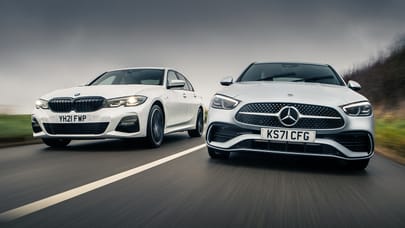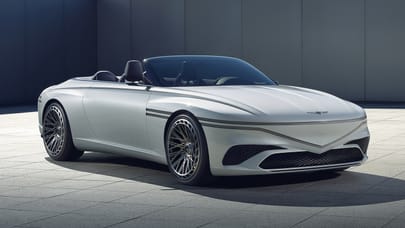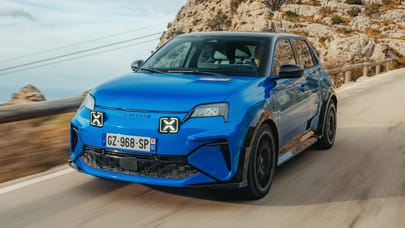
Gallery: a brief history of Aston Martin's DB cars
Aston Super GT returns the DB name to a range-topper. Here's a potted history


The history of Aston Martin is a crash-bang-wallop epic worthy of 007 himself, the secret agent with whom the Gaydon marque has become inextricably intertwined. Drama, death-defying escapes and heroic flourishes: since 1913 Aston has experienced the lot.
For example, in 1922, as well as competing in the French GP for the first time, ‘Bunny’ - an Aston prototype - broke no fewer than ten world records when it averaged 76mph at Brooklands. Just three years later the company was close to insolvency, then rescued, renamed Aston Martin Motors, and relocated to Feltham. Lionel Martin was to leave the business he co-founded just a year later.
Le Mans success followed, preceded by another rescue of the company in 1932, but it wasn’t until 1947 that we reached the ‘David Brown’ era; the gentleman whose initials have adorned Astons since the 1948 2.0-litre Sports, later known as the DB1.
Ups and downs naturally followed, but today we stand before a revitalised AM: with Andy Palmer at the helm a new chassis architecture was developed for the DB11 and Vantage, a deal done with Mercedes for engines and electric gubbins and former Lotus handling expert Matt Becker brought on-board.
So to celebrate the new DBS Superleggera - the company's replacement for the Vanquish S - we thought it worth a trawl through the DB bloodline's rather pretty history.
Which means a look back at the most famous Aston Martin models ever built. Time to pick a favourite…
Advertisement - Page continues below'DB1'

This here is the Two Litre Sports, the very first thing Aston built after Brown bought the company for a little over £20k in 1947. Retrospectively christened the DB1 – because obviously – the Two Litre was launched in 1948. Aston built just 15 of the 90bhp, 93mph roadsters before the DB2 was introduced two years later. It may bear little to no resemblance to modern Astons, but this thing is genesis.
Photo: Aston Martin Heritage Trust
DB2

The DB badge makes its first official appearance. Brown bought Lagonda for its straight-six, which was developed under the watchful eye of W.O Bentley. In swapping the 1’s pushrod four for the six, the DB2 did rather well at Le Mans, where the first three prototypes competed in 1949. It was one of few British cars at the time that could reach 100mph.
Largely based on the DB2, the 2/4 arrived in 1953. Like the DB2 Vantage, with its power hike over the standard 2, it had 125bhp and the ability to go from 0-60mph in, um, 11 seconds. Look, it was the 1950s, OK? And anyway, it could top 120mph, which is a feat, considering it had a live rear axle and drum brakes.
A proper ‘gentleman’s express’, as it was described of the day.
Advertisement - Page continues belowDB2/4 MK3

Known simply as the DB Mk3 (let’s be honest, it’s the DB3), the ultimate version of the DB2 kept the straight-six, albeit heavily revised. With the optional exhaust upgrade, it made 178bhp, which at the time was plenty. 0-60 now took some nine or so seconds. You could have an auto-box if you really wanted it, and disc brakes (at least on the front) were offered as an option on the first 100 cars, and then fitted as standard thereafter. Getting there, Aston…
And then there’s the grille, which in effect remains an Aston hallmark to this day…
A proper DB3 did actually exist. It was a racer, one which borrowed parts from the DB2 Vantage.
DB4

Work on the DB4 began in 1956, with the car finally being shown at the London Motor Show in 1958. It was a brand new car over the DB Mk III it replaced, with aluminium panels fixed onto a tubular frame over a platform chassis.
Then there was that 3.7-litre straight-six, good for 240bhp, 240lb ft of torque and a 0-60mph time of 9.0 seconds. Top speed? 140mph. A convertible arrived in 1961, along with a DB4 GT and numerous model revisions and even a gorgeous Zagato model.
More importantly however, it readied the world for quite possibly the most famous Aston Martin of all time...
DB5

What the DB MK III and DB4 pitched, the DB5 knocked out of the park. The underpinnings were broadly the same as the 4, barring new disc brakes, electric windows, hydraulic brake servos and a bump in engine displacement and power.
So that faithful six-pot engine was now of 4.0-litre capacity, producing 282bhp and 280lb ft of torque. It also got a ZF five-speed ‘box, and could go from 0-60mph in 7.1 seconds.
But those technical advancements were nothing compared to just how bloody iconic the DB5 would become. When Sean Connery as 007 pitched up in a DB5 for Goldfinger, a union formed that etched itself into the worldwide psyche unlike anything before it, and one that remains as strong to this day. Magnificent.
DB6

Largely the same as the DB4 and DB5, though with a noticeable difference: new, redesigned rear three-quarters. The roofline was higher, the wheelbase was longer (for more interior space) and it got new front and rear bumpers.
Otherwise it was the same 4.0-litre sixer and 282bhp, though Aston quotes the 0-60mph time as 6.1s – a full second quicker than the DB5. Celebrity owners included Prince Charles, Paul McCartney (his is pictured above), Mick Jagger, Twiggy and Peter Sellers. Yep, how very ‘60s.
Advertisement - Page continues belowDBS Mk1

The DBS did away with the classic Aston look, which had stuck around since the DB MK3 and died with the DB6 (which was actually sold alongside the DBS for a few years). It had the same engine though – the 4.0-litre six with, if you went for the Vantage kit, 325bhp. Famous for appearing in The Persuaders and On Her Majesty’s Secret Service, the DBS would later morph into the brutish V8…
DB7

Not the most technically advanced Aston – based as it was on the old Jaguar XJS – but sweet lord, it was pretty.
Designed by Ian Callum, it originally came with a supercharged straight-six and 355bhp, which morphed into a mighty V12 when the DB7 became the DB7 Vantage in 1999. Had its issues, sure, but as a design icon, priceless.
Advertisement - Page continues belowDB9

Why no DB8? Aston skipped it because it thought sticking an eight on the back of its new car would lead people to believe it only had eight cylinders, and not that lovely V12 it pinched from the Vanquish.
Still, this was the car that helped kick-start Aston Martin's modern renaissance, and the DB9 was the first Aston to be developed on the VH platform. Many of you won't even care however, at any of this, because to this day, the DB9 remains one of the world's prettiest, classiest GT cars. Just look at it.
DBS Mk2

The Bond connection returns, as this DBS appeared in that scene from Casino Royale. You know the one. The scene that made car enthusiasts weep with sorrow at the sight of a big Aston 'cannon rolling' into the Guinness Book of World Records.
Still, what a car to do it in. This was a harder, fightier version of the DB9, featuring that 6.0-litre V12, 510bhp, and a 0-62mph time of 4.3 seconds. It also got lots of carbon fibre to shave weight over the regular DB9, all wrapped up in that gorgeous, gorgeous body.
DB10

Bond’s most recent wheels. A V8 Vantage underneath all the new metalwork (ahem, 'carbonwork'), the DB10 was a ten-off, built solely to be used and abused by 007 in Spectre. Also gave a handy preview of the new Vantage years before its release. (A Vantage which we've just taken one on an epic road trip around Morocco - watch the video here.)
DB11

The start of a whole new chapter for the company, the DB11 got a new, stiffer bonded aluminium chassis, mildly inflated dimensions over the DB9, and new engines. Not just one, but two - a V12 and now a V8, both turbocharged, the former a 5.2-litre of Aston's own creation and the latter a 4.0-litre borrowed from AMG and fettled. There's a Volante too, such is tradition, but that only gets the V8.
Possibly the best Aston for years - a more complete car than the DB9. Rear our full review.
DBS Superleggera

Isn't it something? The focused new GT gets carbon fibre body panels and a 72kg weight drop over the DB11 V12. On board sits Aston's new 5.2-litre twin-turbo V12, here tweaked for a colossal 715bhp and 664lb ft of torque, sent to the rear wheels via an eight-speed auto, to the tune of 0-62mph in 3.4s.
Flat out, you'll be travelling across the earth at 211mph. And in some style, too.
There were the ‘DBR’ race cars, too...

Which ranked all the way up to the DBR9, but arguably the most significant is the first: the DBR1.
This was the car raced by none other than Roy Salvadori and Carroll Shelby in the 1959 Le Mans 24hrs. With help from engineer Ted Cutting, the trio managed to score an outright win.
Oh, and a chap named Sir Stirling Moss also tasted victory in the DBR1, when in 1958 he won the Goodwood Tourist Trophy. It featured a 3.0-litre straight-six, a five-speed gearbox and 250 of England’s finest horses.
All wrapped up inside a package that looks gorgeous to this day.
Trending this week
- Electric
Top Gear's top 20 electric cars









